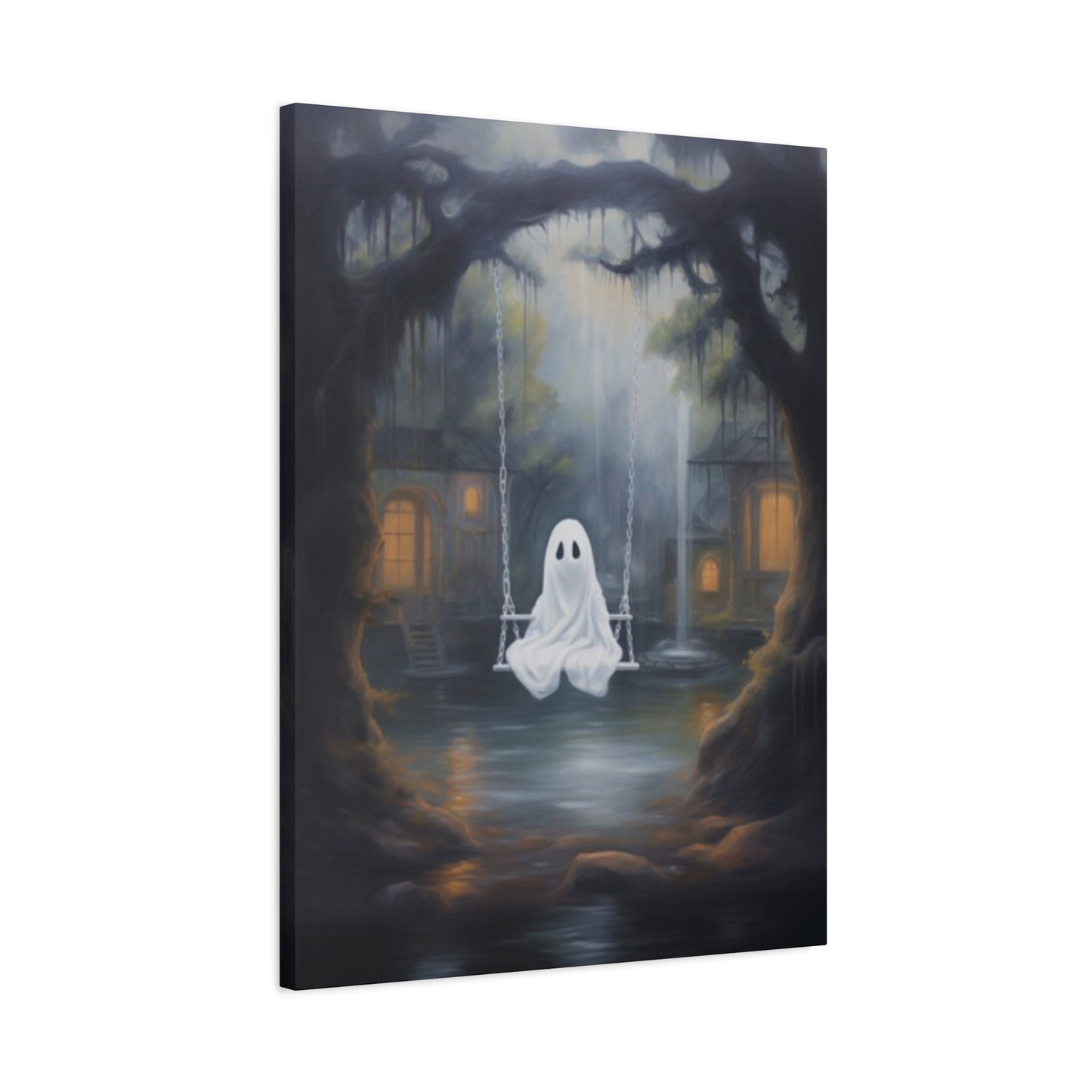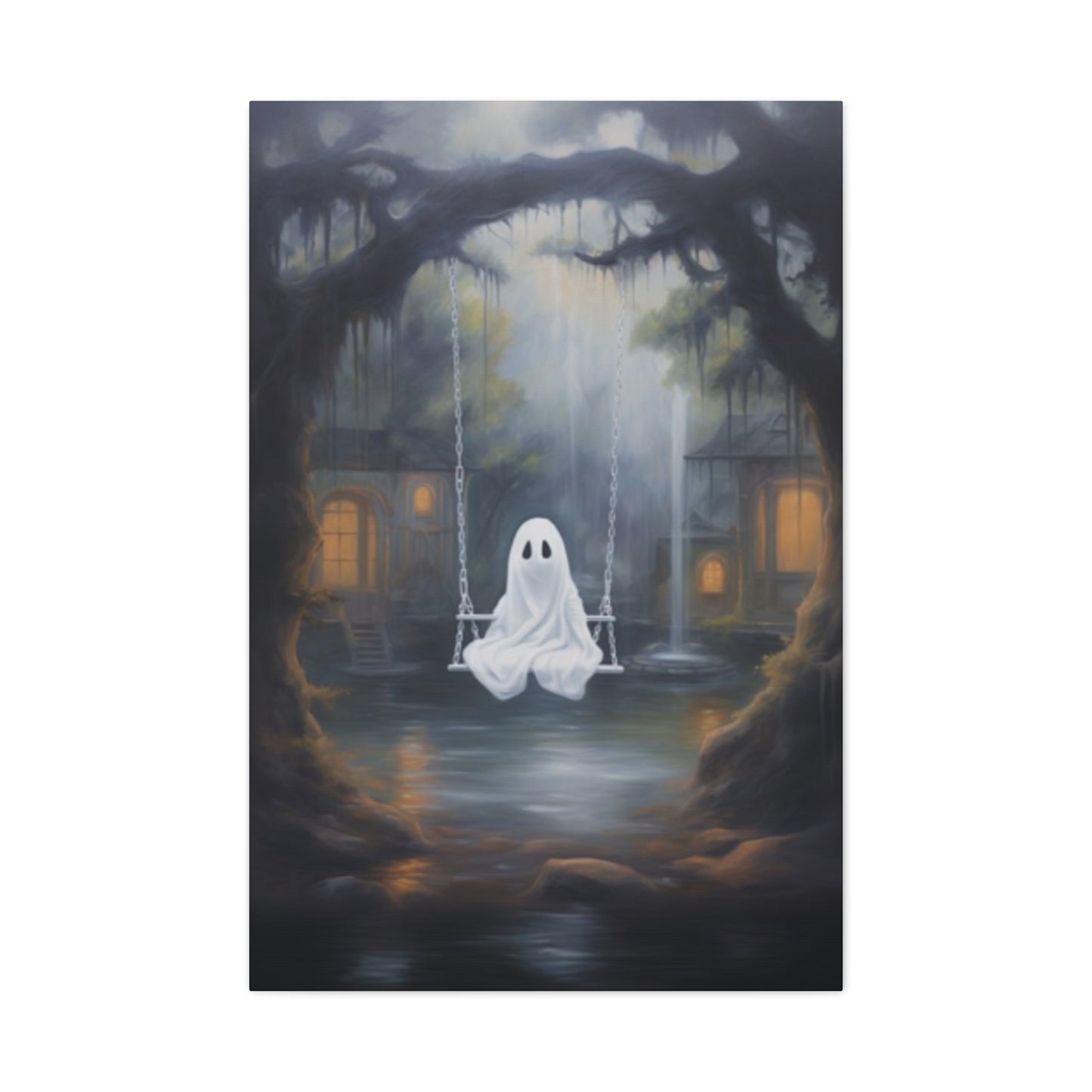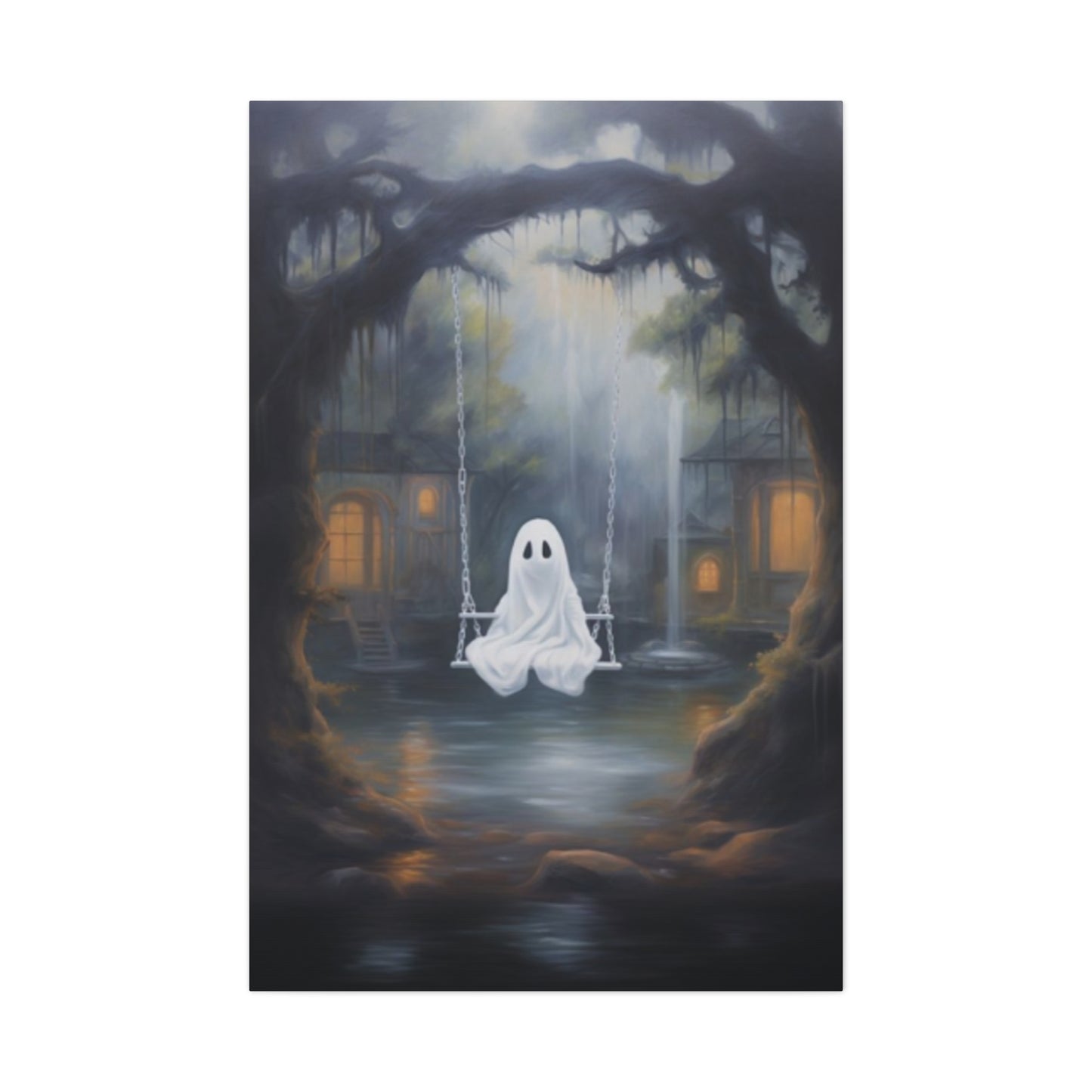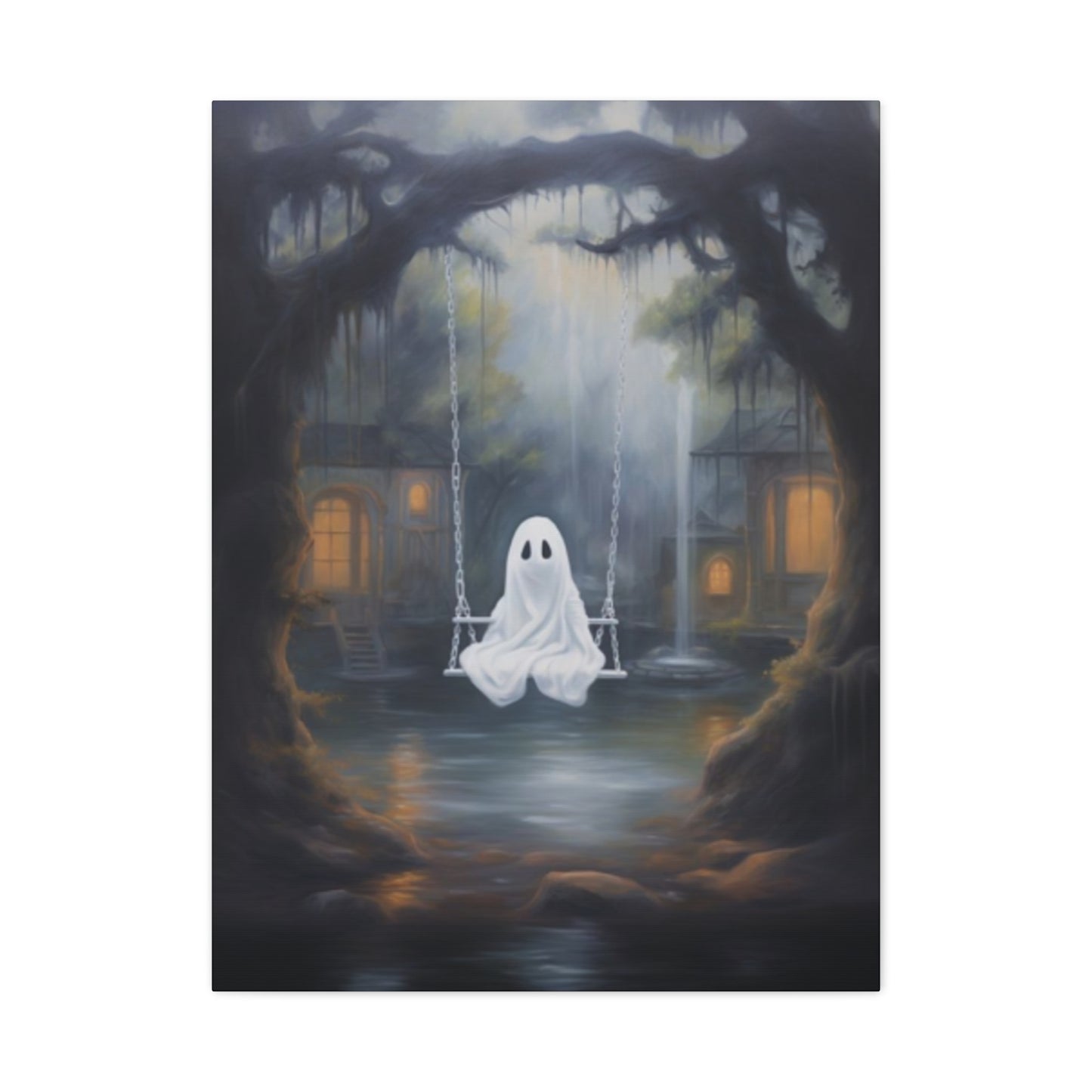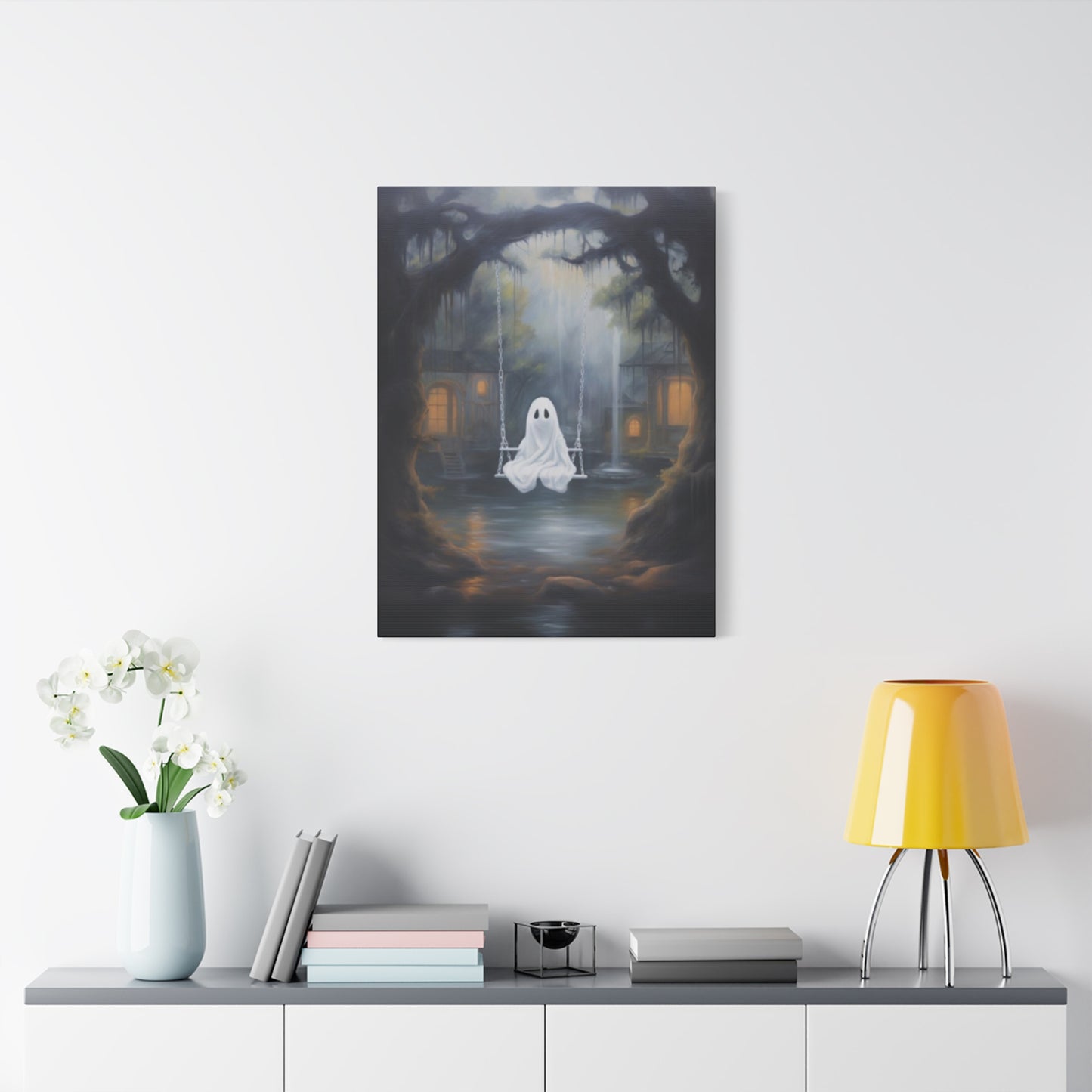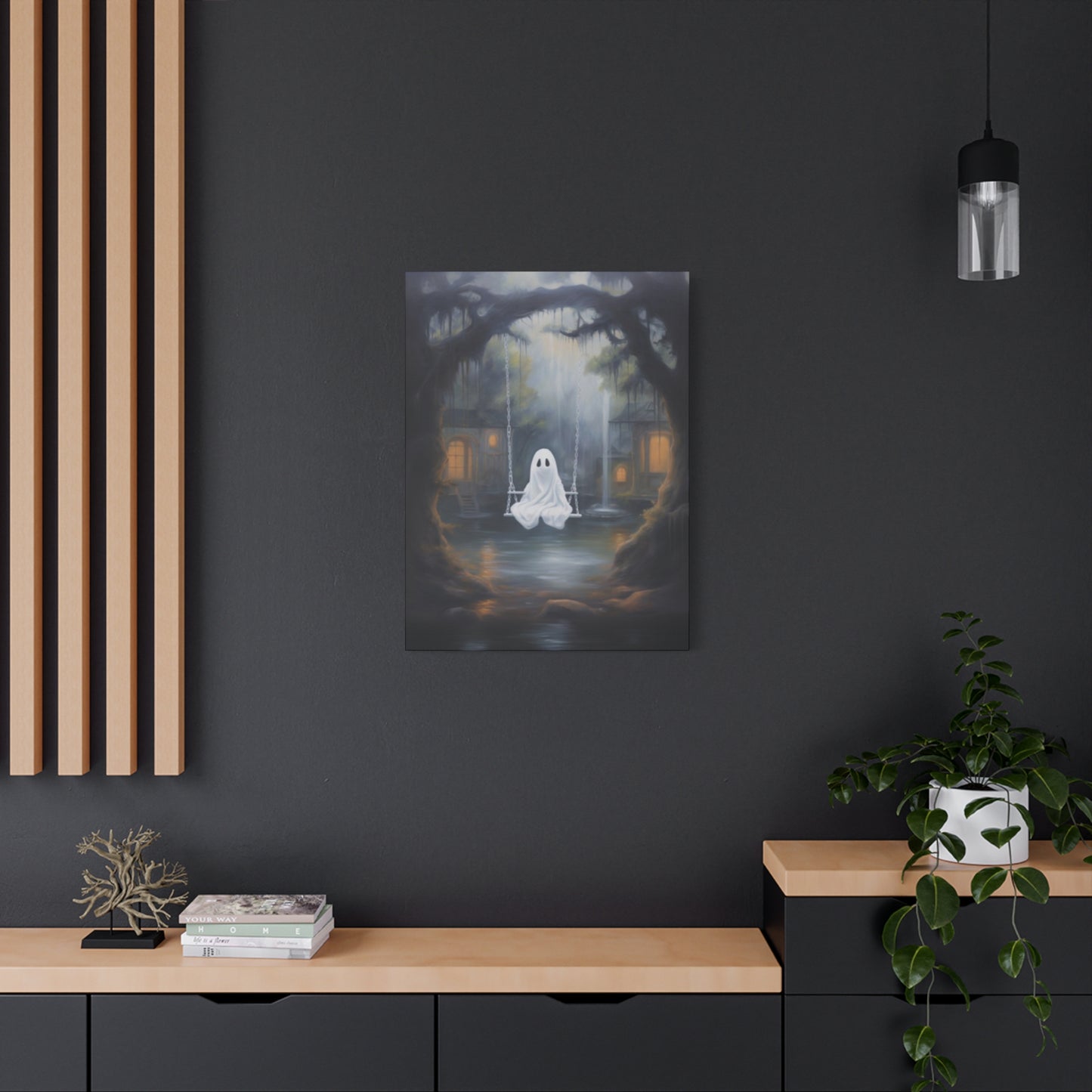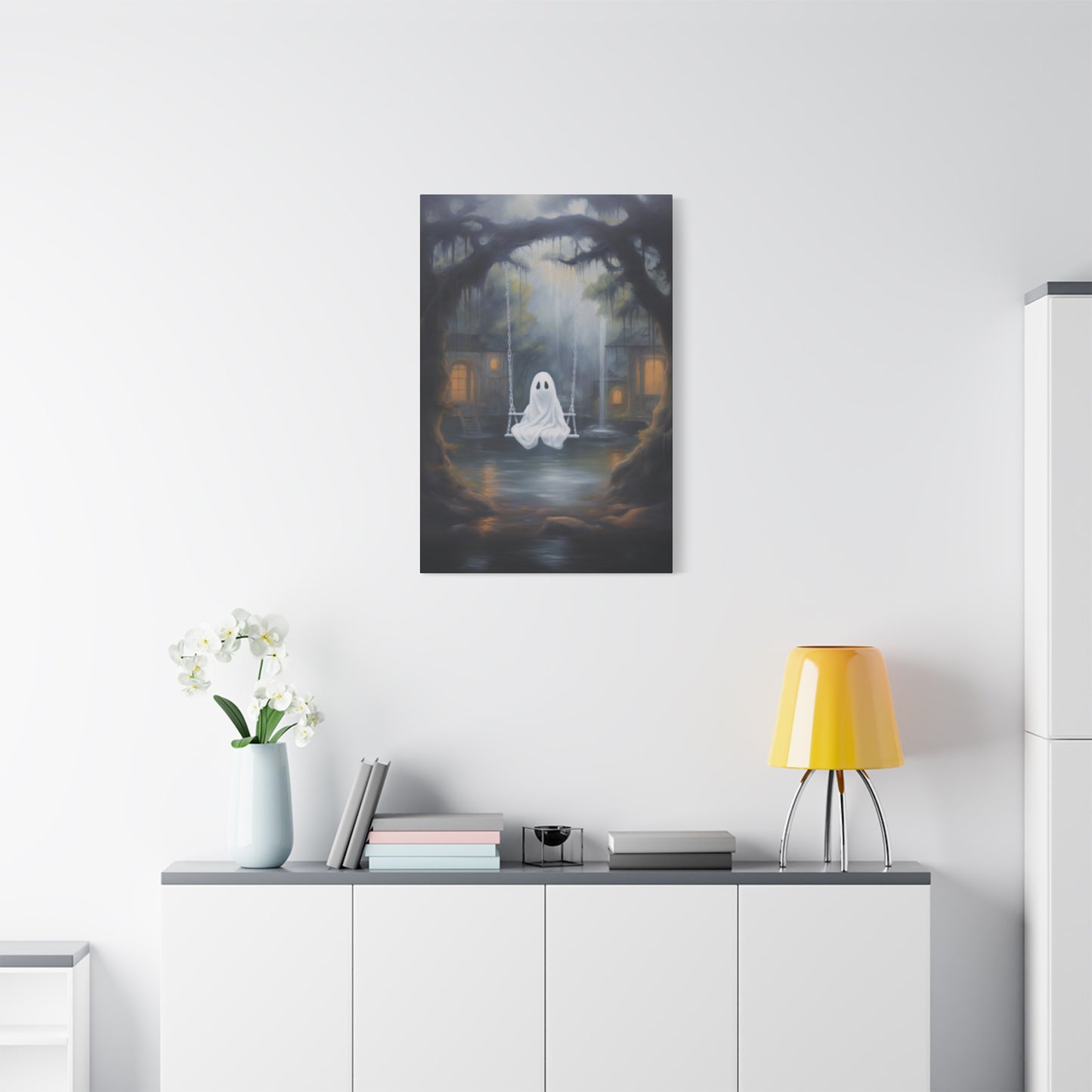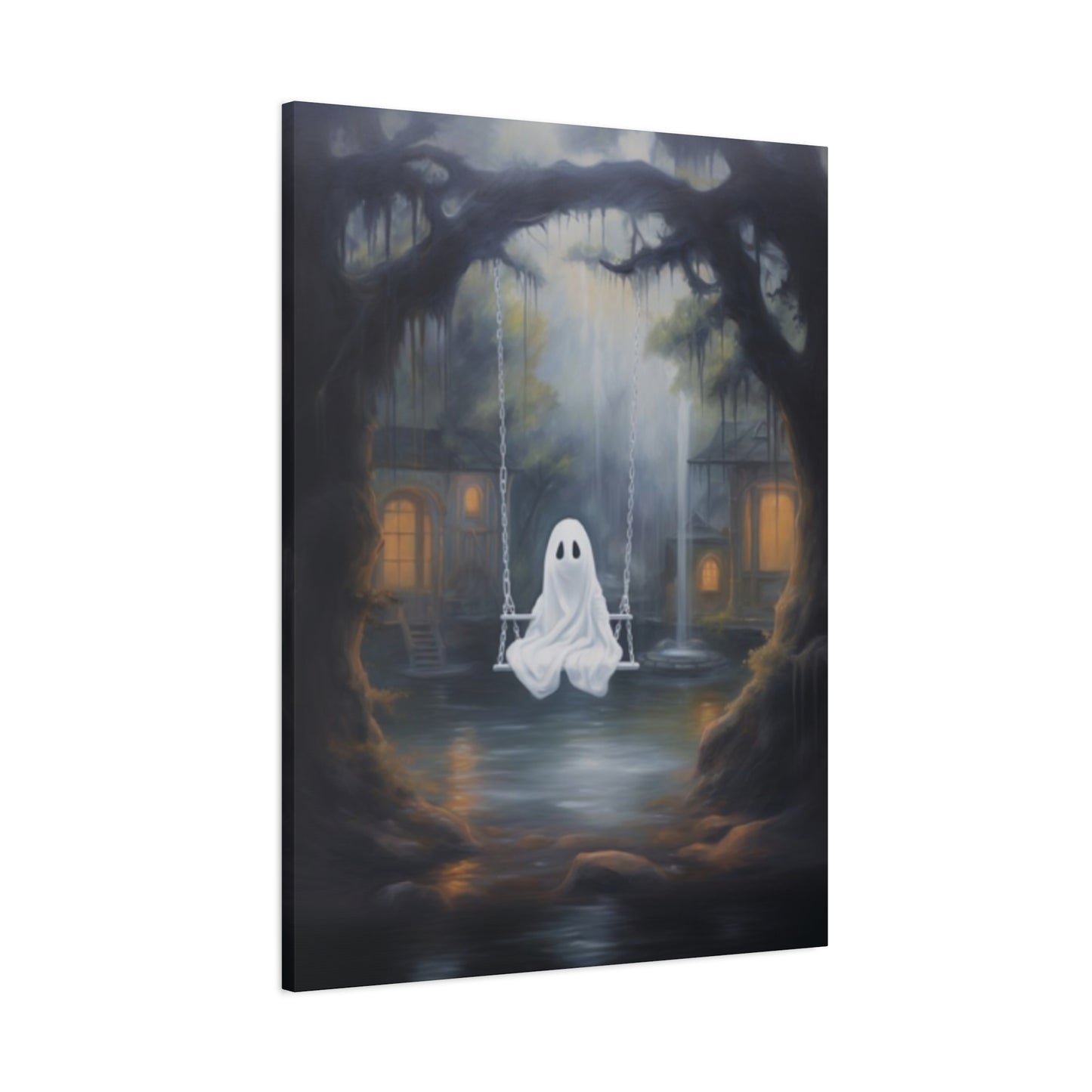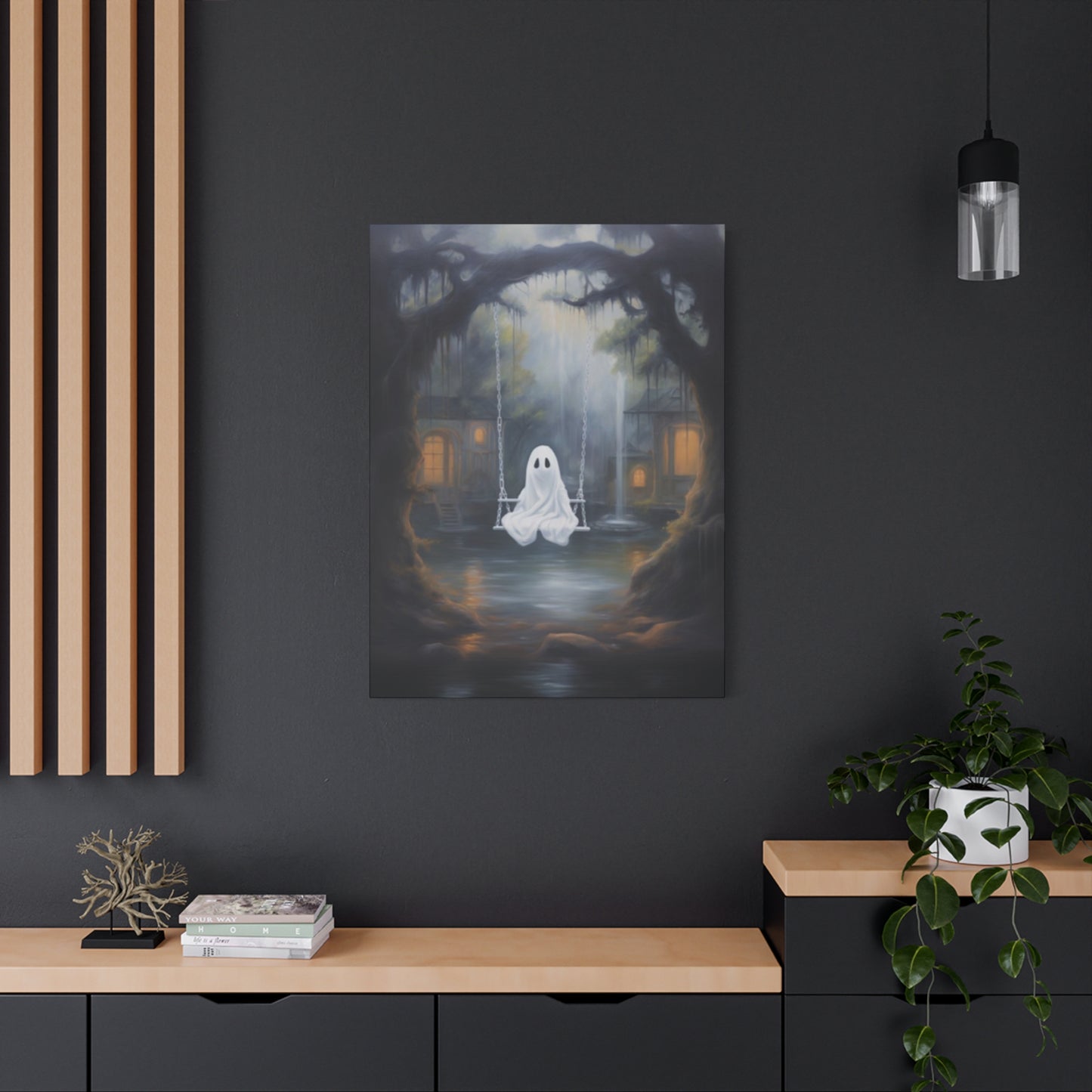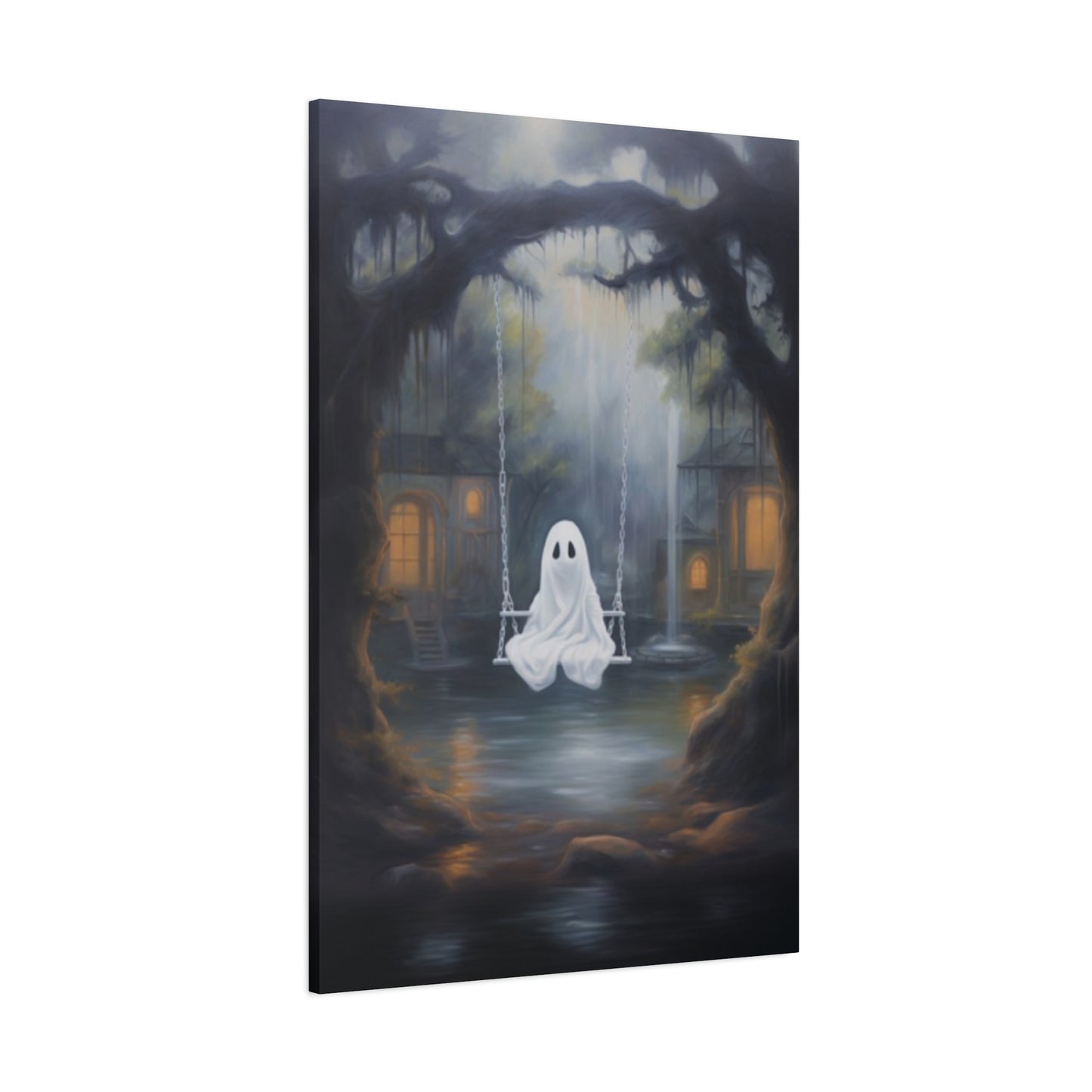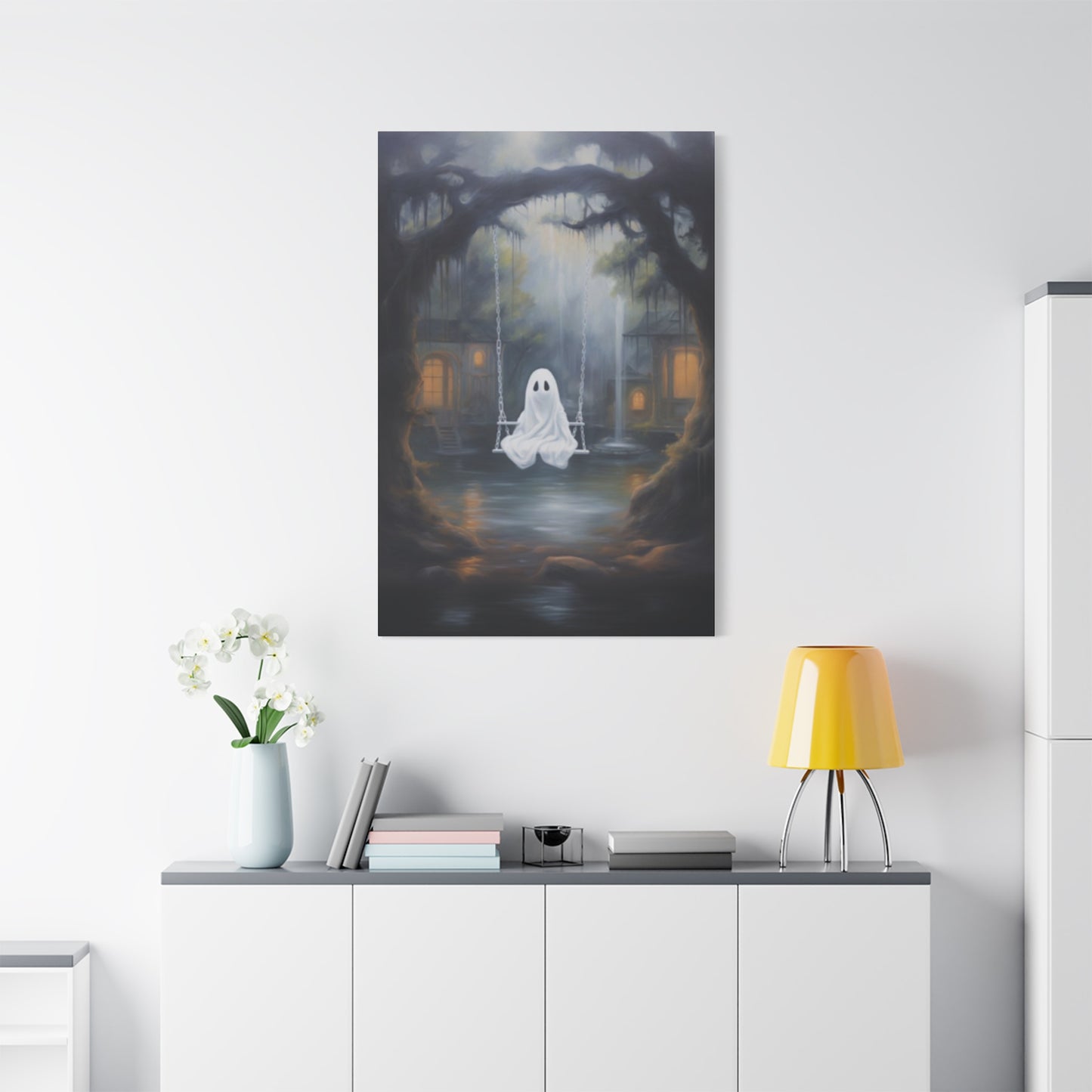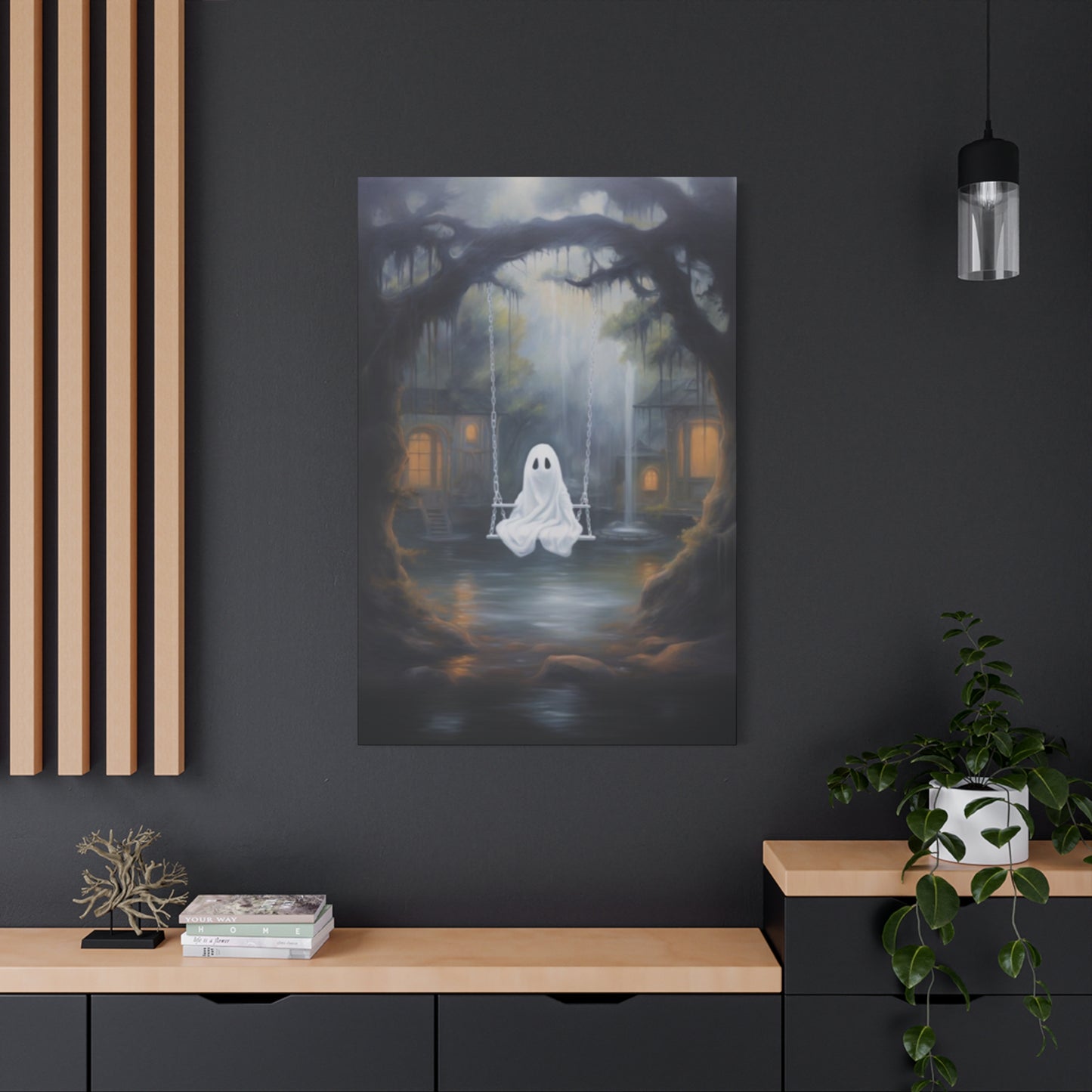Scary Swing Halloween Wall Art Add a Haunting Touch to Your Walls
The fascination with swing-themed Halloween artwork stems from the psychological impact of childhood innocence transformed into something sinister. These pieces capture the viewer's attention through their ability to juxtapose familiar playground equipment with supernatural elements, creating an unsettling atmosphere that perfectly complements Halloween celebrations. The swing, typically associated with joy and carefree moments, becomes a vessel for storytelling that explores darker themes of abandonment, ghostly presences, and haunted memories.
When examining swing-themed Halloween art, one discovers layers of meaning that resonate with viewers on multiple levels. The empty swing suggests absence, perhaps of a child who once played there but has since vanished or passed on. This imagery taps into universal fears about loss, abandonment, and the passage of time. Artists skillfully manipulate lighting, shadows, and atmospheric elements to enhance these emotional responses, creating pieces that linger in the mind long after viewing.
The artistic techniques employed in creating these haunting pieces often involve muted color palettes dominated by grays, blacks, and deep purples, occasionally punctuated by ghostly whites or eerie greens. These color choices contribute to the overall mood while ensuring the artwork remains sophisticated enough for year-round display. The brushwork itself may vary from hyperrealistic detail to impressionistic suggestions of form, allowing viewers to fill in gaps with their imagination.
Professional artists and hobbyists alike find swing-themed Halloween art appealing because it offers endless possibilities for creative interpretation. Some artists focus on photorealistic depictions of abandoned playgrounds under moonlight, while others prefer abstract representations that suggest rather than explicitly show the supernatural elements. This versatility makes swing artwork suitable for various decorating styles and personal preferences.
The market for Halloween-themed artwork has grown significantly in recent years, with collectors seeking pieces that transcend seasonal decoration to become year-round conversation starters. Swing paintings and prints fulfill this desire by offering sophistication alongside their spooky appeal. Many pieces are subtle enough to remain displayed throughout the year while still providing the perfect Halloween atmosphere when the season arrives.
Enhancing Atmospheric Appeal Through Swing Painting Wall Decorations
The strategic placement of swing painting wall decorations can dramatically alter the mood of any room, creating an atmosphere that ranges from subtly unsettling to overtly haunting. These artistic pieces work particularly well in areas where people gather, as they naturally draw attention and spark conversations about their deeper meanings and artistic merit. The key to successfully incorporating these decorations lies in understanding how they interact with existing room elements and lighting conditions.
When considering swing painting wall decorations, the surrounding environment plays a crucial role in their impact. Rooms with natural architectural features like exposed beams, brick walls, or vintage moldings provide ideal backdrops for these pieces. The contrast between the rustic or traditional elements and the haunting subject matter creates a dynamic visual relationship that enhances both the artwork and the room's character. However, modern minimalist settings can also benefit from these pieces, as the stark contrast between clean lines and supernatural imagery creates its own compelling aesthetic.
Lighting considerations are paramount when displaying swing-themed Halloween art. Natural lighting during different times of day can dramatically change how these pieces are perceived. Morning light might reveal subtle details and softer emotions within the artwork, while evening illumination from artificial sources can emphasize the more mysterious and haunting aspects. Many collectors install adjustable lighting systems specifically to highlight these pieces during Halloween season while maintaining appropriate illumination for year-round appreciation.
The psychological impact of swing painting wall decorations extends beyond their immediate visual appeal. These pieces often serve as emotional anchors in a room, providing focal points that influence the overall energy and atmosphere. Guests frequently find themselves drawn to examine these works closely, discovering new details and interpretations with each viewing. This quality makes them excellent conversation starters and memorable elements that define a living area's personality.
Professional decorators recognize the versatility of swing-themed artwork in various design schemes. These pieces complement both traditional Halloween decorating approaches and more sophisticated year-round aesthetic preferences. The key lies in selecting pieces that balance spooky elements with artistic merit, ensuring they remain visually appealing regardless of the season. Many homeowners find that investing in quality swing-themed artwork provides better long-term value than purely seasonal decorations.
Sophisticated Yet Spine-Tingling Halloween Swing Canvas Concepts
Creating sophisticated yet spine-tingling Halloween swing canvas concepts requires careful attention to artistic elements that transcend typical holiday decorations. These canvases must balance haunting imagery with aesthetic sophistication, ensuring they appeal to viewers seeking both seasonal atmosphere and lasting artistic value. The most successful pieces in this category achieve their impact through subtle suggestion rather than overt horror, allowing viewers' imaginations to contribute to the overall experience.
The canvas medium itself offers unique advantages for swing-themed Halloween art. The texture of canvas can enhance the mysterious qualities of these pieces, with different weaving patterns and surface treatments contributing to the overall mood. Some artists prefer smooth, fine-grain canvases that allow for detailed realistic work, while others choose rougher textures that add to the aged, weathered appearance of their haunted scenes. The choice of canvas preparation also affects how paints interact with the surface, influencing the final appearance of atmospheric elements like fog, shadows, and moonlight.
Color theory plays a crucial role in developing sophisticated swing canvas concepts. Rather than relying on obvious Halloween colors like bright orange and green, skilled artists employ more nuanced palettes that create subtle emotional responses. Deep burgundies, muted golds, and steel grays can evoke autumn feelings while maintaining an air of mystery. These sophisticated color choices ensure the artwork remains aesthetically pleasing throughout the year while still providing appropriate Halloween atmosphere when desired.
Composition techniques in swing canvas art often employ principles of visual storytelling that guide viewers through the piece while leaving room for personal interpretation. The placement of the swing within the frame, the angle of viewing, and the inclusion or exclusion of background elements all contribute to the narrative quality of the work. Some compositions focus tightly on the swing itself, creating intimate psychological studies, while others include broader environmental contexts that suggest larger stories about the location and its history.
The technical execution of these canvas pieces requires mastery of various painting techniques that contribute to their haunting appeal. Glazing techniques can create luminous atmospheric effects that suggest supernatural presences, while dry brush methods might be used to create weathered textures on swing chains or support structures. Many artists combine traditional painting methods with modern materials and techniques, allowing for unique visual effects that enhance the mysterious qualities of their work.
Haunting Memories of Youth Through Sinister Swing Artwork
The psychological power of haunting memories of youth through sinister swing artwork lies in its ability to transform universally positive childhood experiences into sources of unease and reflection. These pieces tap into collective memories of carefree playground days while introducing elements that suggest darker possibilities, creating an emotional complexity that resonates with viewers on deeply personal levels. The artistic interpretation of childhood innocence lost or corrupted provides rich material for both creation and contemplation.
Artists exploring this theme often draw inspiration from personal experiences and cultural memories of childhood play. The swing becomes a symbol for lost innocence, abandoned joy, or interrupted childhood, depending on the specific artistic interpretation. Some pieces focus on realistic depictions of weathered playground equipment in abandoned locations, while others take more abstract approaches that suggest rather than explicitly show the transformation from innocent play to haunting memory.
The temporal aspect of these artworks adds another layer of complexity to their interpretation. Many pieces suggest the passage of time through visual elements like rust, decay, overgrown vegetation, or changing weather conditions. These details help viewers understand that the innocent childhood moments associated with swings have passed, leaving only memories and perhaps supernatural echoes of former joy. The contrast between past happiness and present abandonment creates emotional tension that defines much of this artistic genre.
Professional artists working in this area often spend considerable time researching abandoned playgrounds, historical photographs, and cultural references to childhood play. This research informs their artistic choices and helps ensure their work resonates with viewers' own memories and experiences. The most effective pieces in this category achieve a balance between specific detail and universal symbolism, allowing diverse audiences to connect with the artwork on personal levels.
The market for childhood-themed horror art has expanded significantly as collectors seek pieces that offer both emotional depth and sophisticated artistic execution. These works appeal to adults who appreciate the complex emotions associated with growing up while also enjoying the atmospheric qualities that make them suitable for Halloween display. The best pieces in this category transcend seasonal decoration to become permanent elements of personal art collections.
Frightening Swing Paintings That Establish Ominous Atmospheres
Frightening swing paintings that establish ominous atmospheres rely on carefully orchestrated visual elements that work together to create feelings of unease and supernatural presence. These artworks go beyond simple scary imagery to create immersive experiences that affect viewers' emotional states and perceptions of their surroundings. The most successful pieces in this category achieve their impact through subtle manipulation of familiar elements rather than relying on obvious shock value.
The atmospheric qualities of these paintings often depend on masterful use of lighting effects that suggest supernatural or otherworldly influences. Artists might employ techniques like rim lighting to create silhouettes of swings against ominous skies, or use filtered moonlight to cast elongated shadows that suggest movement where none should exist. These lighting choices contribute to the overall mood while demonstrating technical skill and artistic sophistication.
Weather effects play significant roles in establishing ominous atmospheres within swing paintings. Approaching storms, swirling fog, or unnatural calm can all contribute to feelings of impending dread or supernatural presence. Artists often spend considerable time studying meteorological phenomena and their visual effects to accurately portray these atmospheric conditions. The interaction between weather elements and the swing itself can suggest stories about supernatural events or haunted locations.
Sound visualization represents another technique employed in creating atmospheric swing paintings. While paintings cannot produce actual sound, skilled artists can suggest auditory experiences through visual cues. Viewers might imagine the creaking of chains, the whisper of wind, or the absence of normal environmental sounds when viewing these pieces. This synesthetic quality adds depth to the viewing experience and contributes to the overall atmospheric impact.
The psychological aspects of ominous atmosphere creation involve understanding how viewers respond to various visual triggers and emotional cues. Colors, compositions, and symbolic elements all contribute to subconscious reactions that create feelings of unease or supernatural awareness. Artists working in this area often study psychology and emotional response to ensure their work achieves the desired atmospheric effects while maintaining artistic integrity and appeal.
Halloween Wall Art That Narrates Supernatural Stories
Halloween wall art that narrates supernatural stories elevates decorative pieces to the level of visual literature, offering viewers complex narratives that unfold through careful examination and interpretation. These artworks function as silent storytellers, using visual elements to suggest characters, conflicts, and resolutions while leaving enough ambiguity to engage viewers' imaginations. The swing becomes a central character or setting in these visual narratives, contributing to stories that range from subtle ghost tales to epic supernatural adventures.
The narrative structure of these pieces often follows traditional storytelling patterns while adapting them to visual mediums. Beginning elements might include establishing shots of the swing's environment, introducing viewers to the setting and atmosphere. Middle sections could suggest conflict or supernatural encounters through visual cues like disturbed surroundings, unusual lighting, or symbolic elements. Resolution might be implied rather than explicitly shown, allowing viewers to complete the stories in their own minds.
Character development within these visual narratives requires sophisticated artistic techniques that suggest personality, emotion, and motivation without explicit representation. The swing itself might represent a character, with its condition, position, and surroundings telling viewers about its history and significance. Ghostly figures, if present, are often suggested rather than clearly depicted, maintaining mystery while contributing to the overall narrative structure.
Environmental storytelling plays a crucial role in these narrative artworks. The setting surrounding the swing becomes part of the story, with details like abandoned buildings, overgrown paths, or unusual natural phenomena contributing to the overall tale. These environmental elements provide context and background information that help viewers understand the supernatural events being suggested through the artwork.
The temporal aspects of visual storytelling allow these pieces to suggest events that occurred before, during, or after the moment captured in the artwork. Viewers might see evidence of past activities, witness ongoing supernatural events, or anticipate future developments based on visual clues embedded within the composition. This temporal complexity adds depth to the viewing experience and encourages repeated examination of the artwork.
From Innocuous to Unsettling: Swings in Horror-Themed Art
The transformation from innocuous to unsettling in swing-themed horror art demonstrates the power of context and artistic interpretation to completely alter the meaning and emotional impact of familiar objects. This artistic process involves taking something universally associated with childhood joy and play, then carefully introducing elements that subvert these positive associations to create feelings of unease, mystery, or outright fear. The effectiveness of this transformation depends on the artist's skill in maintaining enough familiar elements to trigger positive memories while introducing sufficient unsettling details to create emotional conflict.
The psychology behind this transformation relates to the uncanny valley effect, where familiar objects presented in unfamiliar contexts create feelings of discomfort or unease. Swings in horror art often retain their basic recognizable form while being placed in threatening environments, shown in states of decay, or associated with supernatural elements. This combination of familiar and unfamiliar creates cognitive dissonance that enhances the emotional impact of the artwork.
Artists employing this transformative approach often begin with traditional, pleasant swing imagery before gradually introducing disturbing elements. These might include environmental changes like fog, storm clouds, or unnatural lighting, or physical alterations to the swing itself such as broken chains, weathering, or supernatural modifications. The key lies in maintaining enough of the original positive associations to create emotional tension with the newly introduced threatening elements.
Color manipulation represents one of the most effective techniques for transforming innocent swing imagery into something unsettling. Warm, cheerful colors associated with playground scenes can be replaced with cool, muted tones that suggest abandonment or supernatural influence. The strategic use of shadows, highlights, and atmospheric effects can completely change how viewers perceive the same basic subject matter.
The cultural significance of this artistic transformation extends beyond individual pieces to comment on broader themes like lost innocence, the passage of time, and the hidden darkness that might lurk beneath surface appearances. These works often serve as metaphors for personal or societal experiences, using the familiar image of a swing to explore complex emotional and philosophical territory.
The Influence of Quietude: Haunted Swing Art Interpretation
The influence of quietude in haunted swing art interpretation reveals how silence and stillness can be more psychologically powerful than obvious action or dramatic imagery. These pieces derive their haunting qualities from what is not shown or heard rather than from explicit supernatural elements, creating an atmosphere of anticipation and unease that engages viewers' imaginations more effectively than overt horror imagery. The power of silence in visual art demonstrates sophisticated understanding of psychological response and artistic subtlety.
Quietude in swing art often manifests through empty swings that suggest recent or potential occupancy without showing actual figures. The absence of movement in an object designed for motion creates an inherent tension that viewers feel subconsciously. This stillness can suggest supernatural suspension of natural laws, abandonment of joyful activities, or the presence of invisible forces that prevent normal function.
The visual representation of silence requires sophisticated artistic techniques that suggest auditory experiences through purely visual means. Artists might use muted color palettes, soft edges, or atmospheric effects that visually communicate the absence of sound. The portrayal of environmental elements like grass, trees, or buildings can suggest whether they exist in normal, living environments or in supernatural states of suspension where normal sounds would be absent.
Psychological interpretations of quiet swing art often relate to meditation on mortality, memory, and the spaces between life and death. The stillness of the swing can represent the pause between breaths, the moment between life and whatever comes after, or the suspension of time that occurs in supernatural encounters. These deeper meanings add intellectual weight to pieces that might otherwise be dismissed as simple Halloween decorations.
The artistic challenge of creating powerful quiet moments in visual art requires mastery of subtle techniques that create emotional impact without relying on obvious dramatic elements. Successful quiet swing art demonstrates that sophisticated viewers often find subtle, contemplative pieces more emotionally affecting than works that attempt to create impact through shock or obvious scary imagery.
Establishing Dramatic Centerpieces with Eerie Swing Wall Art
Establishing dramatic centerpieces with eerie swing wall art requires careful consideration of how these pieces interact with their surrounding environments to create maximum visual and emotional impact. These artworks must command attention while complementing rather than overwhelming the existing design elements in a room. The most successful centerpiece swing art achieves this balance through sophisticated composition, appropriate sizing, and strategic placement that enhances both the artwork and its surroundings.
The scale and proportions of centerpiece swing art must be carefully calculated to ensure proper visual weight within the room. Pieces that are too small may get lost among other elements, while oversized works might dominate to the point of creating discomfort rather than atmospheric enhancement. Professional designers often recommend that centerpiece art occupy approximately one-third of the available wall area, though this guideline must be adjusted based on the specific characteristics of both the artwork and the room.
Placement considerations for dramatic centerpieces extend beyond simple wall mounting to include viewing angles, lighting interactions, and relationship to other room elements. The ideal placement allows viewers to appreciate the artwork from multiple positions while ensuring it remains visible and impactful from the primary seating or traffic areas. Height placement should consider both the artwork's internal composition and the typical viewing positions of room occupants.
The interaction between centerpiece swing art and room lighting can dramatically affect its impact and mood contribution. Natural light sources might reveal different aspects of the artwork throughout the day, while artificial lighting can be controlled to emphasize specific elements or create particular atmospheric effects. Many homeowners install adjustable lighting specifically for their centerpiece art, allowing them to modify the mood and impact based on occasions or seasons.
Supporting elements within the room should complement rather than compete with dramatic centerpiece swing art. This might involve adjusting color schemes, textures, or decorative accessories to enhance the artwork's impact while maintaining overall room harmony. The goal is to create a cohesive environment where the centerpiece art feels integral to the overall design rather than simply attached as an afterthought.
Embracing Shadows: Frightening Swing Canvas Collections
Embracing shadows in frightening swing canvas collections involves understanding how darkness and light work together to create psychological depth and emotional complexity in artistic works. These collections benefit from careful curation that considers how individual pieces relate to each other while maintaining their individual impact and artistic merit. The most successful collections create overarching themes or narratives that connect the pieces while allowing each work to contribute its unique perspective to the larger artistic statement.
Shadow techniques in swing canvas art encompass both literal representation of darkness and metaphorical exploration of hidden or suppressed elements. Artists might use actual shadows cast by swings, chains, or surrounding structures to create dramatic visual effects, while also employing shadows as symbols for unconscious fears, hidden memories, or supernatural presences. The interplay between literal and metaphorical shadows adds layers of meaning that reward careful viewing and interpretation.
Color relationships within shadow-focused collections require sophisticated understanding of how different hues interact in low-light or high-contrast situations. Deep purples, navy blues, and charcoal grays create rich shadow areas that maintain visual interest while suggesting depth and mystery. These darker tones must be balanced with strategic use of lighter elements that prevent the overall collection from becoming visually murky or emotionally oppressive.
The arrangement and display of shadow-themed swing collections should consider how the pieces work together to create unified atmospheric effects. This might involve grouping pieces with similar shadow treatments, creating gradual transitions between different approaches to darkness, or using lighting to enhance the shadow effects within individual pieces. Professional curators often spend considerable time experimenting with different arrangement options to achieve optimal impact.
Collecting strategies for shadow-themed swing art might focus on acquiring pieces from specific artists known for their mastery of darkness, gathering works that represent different technical approaches to shadow creation, or building collections that tell cohesive stories through their shadow-related imagery. The investment potential of these collections often depends on the artistic quality of individual pieces and the coherence of the overall collecting vision.
Ideal Halloween Enhancements: Swing-Inspired Artistic Pieces
Ideal Halloween enhancements through swing-inspired artistic pieces require balance between seasonal appropriateness and lasting aesthetic appeal that justifies year-round display. These pieces must capture the specific atmospheric qualities associated with Halloween while maintaining sufficient artistic sophistication to function as permanent design elements rather than temporary decorations. The most successful Halloween swing art achieves this dual purpose through careful attention to both seasonal symbolism and timeless artistic principles.
The symbolic associations between swings and Halloween themes create natural connections that artists can explore in various ways. Swings represent childhood innocence, which Halloween traditions often subvert or transform through supernatural elements. This inherent thematic connection provides rich material for artistic interpretation while ensuring the resulting pieces feel authentic to both childhood experiences and Halloween mythology.
Seasonal color palettes for Halloween swing art typically include the traditional orange and black combinations, but sophisticated pieces often employ more subtle variations that suggest autumn and supernatural themes without appearing cartoonish or overly commercial. Deep oranges, burnt siennas, golden browns, and rich purples can evoke Halloween feelings while maintaining the artistic integrity necessary for year-round appreciation.
The integration of Halloween swing art into existing home environments requires consideration of how these pieces will function during both Halloween season and the remainder of the year. Successful integration often involves selecting pieces that emphasize the mysterious or atmospheric aspects of Halloween rather than its more commercial or overtly scary elements. This approach ensures the artwork remains appropriate and appealing regardless of the season.
Market considerations for Halloween swing art include both immediate seasonal demand and long-term collecting potential. Pieces that successfully balance Halloween themes with artistic merit often maintain their value better than purely seasonal decorations while also providing greater satisfaction to their owners. Collectors frequently seek works that offer the excitement of Halloween celebration combined with the lasting pleasure of owning significant artwork.
Phantom Figures on Swings: A Classic Halloween Motif
Phantom figures on swings represent a classic Halloween motif that combines supernatural elements with nostalgic childhood imagery to create powerful emotional and visual impact. These artistic representations tap into universal fears about death, abandonment, and the persistence of memory while maintaining enough familiar elements to create personal connections for viewers. The effectiveness of phantom swing imagery depends on artists' ability to suggest rather than explicitly show supernatural presences, allowing viewers' imaginations to contribute to the overall experience.
The artistic techniques used to depict phantom figures range from subtle suggestion through atmospheric effects to more direct representation using translucent or ethereal visual elements. Some artists prefer to indicate phantom presence through environmental disturbances like moving chains, disturbed ground, or unusual lighting effects, while others choose to include ghostly figures rendered in translucent or impressionistic styles. The choice of technique often depends on the intended emotional impact and the overall aesthetic approach of the piece.
Historical and cultural references inform many phantom swing artworks, drawing inspiration from ghost stories, folklore, and supernatural traditions from various cultures. These references add depth and authenticity to the works while connecting them to broader cultural narratives about death, memory, and supernatural persistence. Artists often research specific ghost stories or local legends to inform their artistic interpretations.
The psychological appeal of phantom swing imagery relates to fundamental human concerns about mortality and the continuation of consciousness after death. These pieces allow viewers to contemplate these serious topics within the safer context of artistic appreciation and Halloween celebration. The combination of childhood innocence with supernatural themes creates emotional complexity that appeals to adult sensibilities while remaining accessible to younger viewers.
Contemporary interpretations of phantom swing motifs often incorporate modern artistic techniques and cultural references while maintaining connection to traditional supernatural themes. Digital art, mixed media, and contemporary color palettes can refresh classic motifs for modern audiences while preserving their essential emotional and symbolic impact.
Evoking Dread Through Minimalist Swing Wall Prints
Evoking dread through minimalist swing wall prints demonstrates how artistic restraint and careful selection of elements can create more powerful emotional effects than busy or overly dramatic compositions. These pieces rely on suggestion rather than explicit imagery, engaging viewers' imaginations while maintaining sophisticated aesthetic appeal suitable for contemporary interior design. The minimalist approach to frightening swing art requires masterful understanding of composition, color theory, and psychological response to achieve maximum impact with minimal elements.
The principles of minimalist design in swing art involve eliminating all non-essential elements while retaining those components that contribute most effectively to the intended emotional response. This might mean showing only the swing's silhouette against a stark background, using extreme close-ups of swing chains, or presenting environmental elements that suggest rather than explicitly show the swing's presence. The challenge lies in determining which elements are truly essential for creating the desired atmospheric effect.
Color reduction in minimalist swing prints often involves limiting palettes to two or three carefully selected hues that work together to create specific emotional responses. Monochromatic schemes using various shades of gray can create somber, haunting effects, while limited color combinations might use deep blues and stark whites to suggest moonlight and shadow. The strategic use of color becomes even more important in minimalist work because each hue must contribute meaningfully to the overall impact.
Negative area usage represents a crucial element in minimalist swing art, with empty or blank areas contributing as much to the composition as drawn or painted elements. These negative areas can suggest vast, empty playgrounds, infinite sky, or the absence of normal environmental elements that would typically surround playground equipment. The balance between positive and negative areas creates visual tension that contributes to the overall emotional effect.
The commercial appeal of minimalist swing prints often exceeds that of more complex pieces because their simplified aesthetic integrates more easily into various decorating styles and personal preferences. These pieces can function effectively in modern, traditional, or eclectic environments while maintaining their artistic integrity and emotional impact. The versatility of minimalist swing art makes it particularly attractive to collectors and decorators seeking pieces with broad appeal.
Halloween Art That Carries an Atmosphere of Foreboding
Halloween art that carries an atmosphere of foreboding requires sophisticated understanding of how visual elements combine to create feelings of impending threat or supernatural danger without relying on obvious scary imagery. These pieces must build tension and unease through subtle manipulation of familiar elements, creating psychological effects that linger in viewers' minds long after initial viewing. The most successful foreboding Halloween art achieves its impact through masterful control of atmosphere, composition, and symbolic content.
The creation of foreboding atmospheres often involves careful manipulation of environmental elements that suggest impending change or supernatural intervention. Storm clouds gathering in unnatural formations, wind effects that disturb only certain elements while leaving others untouched, or lighting conditions that seem inconsistent with natural phenomena can all contribute to feelings of unease and anticipation. These atmospheric details must be rendered convincingly to maintain the artwork's credibility while creating the desired emotional effects.
Temporal suggestions play important roles in creating foreboding atmospheres, with visual elements that indicate time moving unnaturally or approaching significant moments. Clocks showing midnight, shadows that fall at impossible angles, or seasonal elements that appear out of their proper sequence can all suggest that supernatural forces are influencing the normal flow of time. These temporal distortions create psychological unease that contributes to the overall foreboding atmosphere.
Symbolic elements within foreboding Halloween art often draw from cultural associations with death, change, or supernatural intervention. Ravens, bare trees, abandoned objects, or architectural elements in states of decay can all suggest impending doom or supernatural presence without explicitly showing threatening entities. The effectiveness of these symbols depends on their integration into the overall composition and their resonance with viewers' cultural knowledge and personal associations.
The market for atmospheric Halloween art has grown significantly as collectors seek pieces that provide sophisticated scary experiences rather than simple shock value. These works appeal to adults who appreciate psychological complexity in their entertainment while also serving as conversation pieces that demonstrate artistic sophistication. The investment potential of atmospheric pieces often exceeds that of more obvious Halloween decorations because they maintain relevance and appeal beyond the seasonal celebration.
Sinister Canvas Concepts: Swings Concealed in Darkness
Sinister canvas concepts featuring swings concealed in darkness explore the psychological power of partial revelation and hidden imagery to create more intense emotional effects than fully visible subjects. These artistic approaches rely on viewers' natural tendency to imagine what cannot be seen, often creating more frightening or unsettling mental images than explicit representation could achieve. The technique of concealing key elements in darkness requires sophisticated understanding of composition, lighting, and psychological response to guide viewers' attention and imagination effectively.
The strategic use of darkness in swing canvas art serves multiple artistic purposes beyond simple concealment. Shadows can create depth and dimensional complexity within the composition while also suggesting supernatural influences that obscure normal visibility. The interplay between hidden and revealed elements creates visual tension that keeps viewers engaged while building atmospheric intensity throughout the viewing experience.
Lighting techniques in dark swing canvases often employ dramatic contrasts between deep shadows and strategic highlights that reveal just enough detail to suggest the swing's presence without fully exposing its condition or surroundings. This selective illumination can create mystery about whether the swing is occupied, damaged, or influenced by supernatural forces, leaving viewers to fill in these crucial details through their own imagination.
The psychological impact of concealed swing imagery relates to fundamental human responses to the unknown and partially visible. These pieces trigger natural curiosity while simultaneously creating unease about what might be hidden in the darkness. The tension between wanting to see more clearly and being afraid of what might be revealed creates lasting emotional engagement that distinguishes these works from more straightforward artistic approaches.
Technical challenges in creating effective darkness-concealed swing art include maintaining enough visual interest in dark areas to prevent the composition from becoming boring while avoiding so much detail that the concealment effect is lost. Artists must master subtle gradations of darkness, strategic use of texture, and careful placement of lighter elements that guide viewers' attention without revealing too much information.
Frightening Swing Paintings for Shadowy Corridors
Frightening swing paintings for shadowy corridors must consider the specific viewing conditions and architectural contexts that define these transitional areas within homes and buildings. These pieces need to function effectively in low-light conditions while providing visual interest for people passing through these areas. The most successful corridor swing paintings create atmospheric continuity that enhances the architectural character of these transitional areas while providing memorable visual experiences for viewers.
The dimensional considerations for corridor art differ significantly from pieces intended for main living areas, with longer, narrower formats often proving more effective than traditional rectangular proportions. Swing paintings designed for corridors might emphasize vertical elements like chains or trees, or employ horizontal compositions that complement the linear nature of hallway areas. The scale must be appropriate for close viewing while remaining impactful enough to attract attention in passing.
Lighting challenges in corridor areas require careful consideration of how swing paintings will appear under various illumination conditions throughout the day and evening. Many corridors rely primarily on artificial lighting, which can dramatically affect how colors and atmospheric effects appear in the artwork. Artists and collectors often need to experiment with different lighting arrangements to achieve optimal presentation of these pieces in corridor environments.
The psychological effects of frightening corridor art relate to the transitional nature of these areas and people's natural vulnerability when moving between different areas of a building. Swing paintings in corridors can create anticipation, unease, or dramatic punctuation between different room environments. The effectiveness of these pieces often depends on their ability to create lasting impressions during brief viewing encounters.
Maintenance and durability considerations for corridor swing paintings include protection from increased traffic, varying lighting conditions, and potential contact with people moving through these areas. Professional-quality framing and protective glazing become even more important in corridor installations where artwork faces greater exposure to environmental variations and physical risks.
Conveying Stories Through Eerie Swing Wall Art
Conveying stories through eerie swing wall art requires sophisticated understanding of visual narrative techniques that can communicate complex tales without relying on written text or obvious sequential imagery. These pieces must function as complete stories unto themselves while leaving enough interpretive room for viewers to contribute their own understanding and emotional responses. The most effective narrative swing art creates immersive experiences that draw viewers into imagined worlds and encourage them to explore the suggested stories through repeated viewing and contemplation.
The structure of visual narratives in swing art often follows traditional storytelling patterns adapted for single-image presentation. Beginning elements might establish setting, character, and initial conditions through environmental details and atmospheric cues. Rising action could be suggested through visual tension, unusual lighting, or disrupted environmental elements. Climactic moments might be implied rather than shown, allowing viewers to imagine peak dramatic events. Resolution often remains ambiguous, encouraging viewers to complete the stories according to their own interpretations.
Character development within single-image swing narratives requires subtle techniques that suggest personality, motivation, and emotional states without explicit representation. The swing itself often serves as a character, with its condition, position, and relationship to surrounding elements telling viewers about its history and significance. Ghostly or supernatural figures, when present, are often suggested rather than clearly depicted, maintaining mystery while contributing to character development.
Environmental storytelling plays crucial roles in narrative swing art, with background elements, weather conditions, and architectural features all contributing to the overall tale being told. Abandoned playgrounds suggest stories of lost childhood or community decay, while supernatural environmental elements might indicate ghost stories or supernatural interventions. These environmental details provide context and background information that help viewers understand the narratives being suggested.
The temporal aspects of visual storytelling allow these pieces to suggest events occurring before, during, or after the moment captured in the artwork. Evidence of past activities, signs of ongoing supernatural events, or anticipation of future developments can all be embedded within single compositions, creating temporal complexity that adds depth to the viewing experience and encourages repeated examination of the artwork.
Terrifying Focal Elements for Halloween Celebrations
Terrifying focal elements for Halloween celebrations must balance seasonal appropriateness with lasting artistic merit while creating maximum dramatic impact within party or decorative settings. These pieces need to command attention and create atmosphere while functioning effectively alongside other Halloween decorations and activities. The most successful terrifying focal elements enhance rather than compete with other celebration elements while providing memorable centerpieces that define the overall mood and aesthetic of the event.
The scale and visual impact of terrifying focal swing art must be calculated to ensure appropriate dominance within Halloween celebration environments. These pieces often need to function effectively alongside lights, other decorations, and crowd activities while maintaining their frightening appeal and artistic integrity. Professional event planners frequently recommend focal pieces that can be appreciated from various distances and viewing angles to accommodate different celebration dynamics.
Durability considerations for celebration focal elements include protection from increased handling, varying environmental conditions, and potential damage from party activities. Temporary installations might use different materials and protective strategies than permanent art installations, while pieces intended for repeated seasonal use require storage and maintenance planning that preserves their impact and appearance over multiple years.
The interaction between terrifying focal art and lighting effects can dramatically enhance the atmosphere of Halloween celebrations. Strategic illumination can emphasize the most frightening aspects of swing art while creating dynamic visual effects that change throughout the celebration. Many event organizers use programmable lighting systems that can modify the mood and impact of focal art based on different celebration activities.
Integration with other celebration elements requires careful planning to ensure terrifying focal swing art complements rather than conflicts with costumes, activities, and other decorative elements. The most successful celebrations create cohesive atmospheric experiences where all elements work together to support the overall theme and mood while allowing individual pieces to contribute their unique impact to the collective experience.
Conclusion
The Scary Swing Halloween Wall Art is a perfect addition to your seasonal décor, bringing an eerie yet captivating atmosphere to any room. This piece uniquely blends haunting imagery with a touch of nostalgia—evoking the unsettling feeling of an empty swing swaying in the moonlight, a classic symbol of spooky storytelling. Whether you’re aiming to create a chilling focal point for your Halloween setup or add subtle spooky vibes year-round, this wall art is sure to leave a lasting impression on guests and residents alike.
Halloween décor thrives on atmosphere, and the Scary Swing artwork captures that mood flawlessly. Its dark, mysterious tones combined with the swinging motion evoke a sense of suspense and the supernatural. This piece taps into childhood fears and ghost stories, bringing those spine-tingling moments into your home in a visually striking way. The artwork invites viewers to imagine the stories behind the empty swing—ghostly visitors, whispered secrets, or the lingering presence of spirits.
Beyond its spooky theme, this wall art adds depth and character to your interior design. Whether hung in a living room, hallway, or entryway, it complements a variety of styles from gothic and rustic to modern minimalist with a dark twist. The blend of shadowy details and sharp contrasts enhances your space’s mood lighting and seasonal atmosphere without overwhelming the overall décor.
The Scary Swing Halloween Wall Art is also a conversation starter. It sparks curiosity and imagination, encouraging guests to share their own spooky tales or Halloween memories. This makes it ideal for Halloween parties or themed gatherings, where the right ambience can elevate the entire experience. Plus, it’s a subtle nod to classic horror themes without resorting to clichés, appealing to both horror aficionados and casual fans of the season.
In conclusion, the Scary Swing Halloween Wall Art perfectly balances eerie aesthetics with artistic elegance. It’s more than just a decoration—it’s an invitation to experience the mystery and thrill of Halloween in a sophisticated and memorable way. Whether you want to create a chilling ambiance or simply celebrate the spooky season with style, this piece brings haunting beauty and a touch of nostalgia to your walls.

















